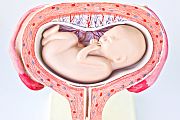Findings have important implications for predicting premature labor, a major global health problem
TUESDAY, Aug. 18, 2015 (HealthDay News) — Certain patterns of vaginal microbiota are associated with higher risk of preterm delivery, according to a study published online Aug. 17 in the Proceedings of the National Academy of Sciences.
Daniel B. DiGiulio, M.D., from the Stanford University School of Medicine in California, and colleagues examined the bacterial taxonomic composition of 3,767 specimens from 40 women during gestation and monthly after delivery. Samples were collected from the vagina, distal gut, saliva, and tooth/gum.
The researchers found that at all four body sites, microbiota community taxonomic composition and diversity remained stable during pregnancy (P > 0.05 for trends over time). There was an inverse correlation between prevalence of a Lactobacillus-poor vaginal community state type (CST 4) and gestational age at delivery (P = 0.0039). Subjects with CST 4 and elevated Gardnerella or Ureaplasma abundances had more pronounced risk for preterm birth. In 246 vaginal specimens from nine women, four of whom delivered preterm, these findings were validated. Most women experienced post-delivery disturbance in the vaginal community, which was characterized by reduction in Lactobacillus species and increases in Peptoniphilus, Prevotella, and Anaerococcus species. These disturbances persisted for up to one year and were unrelated to gestational age at delivery.
“These findings have important implications for predicting premature labor, a major global health problem, and for understanding the potential impact of a persistent, altered postpartum microbiota on maternal health, including outcomes of pregnancies following short interpregnancy intervals,” the authors write.
Copyright © 2015 HealthDay. All rights reserved.








